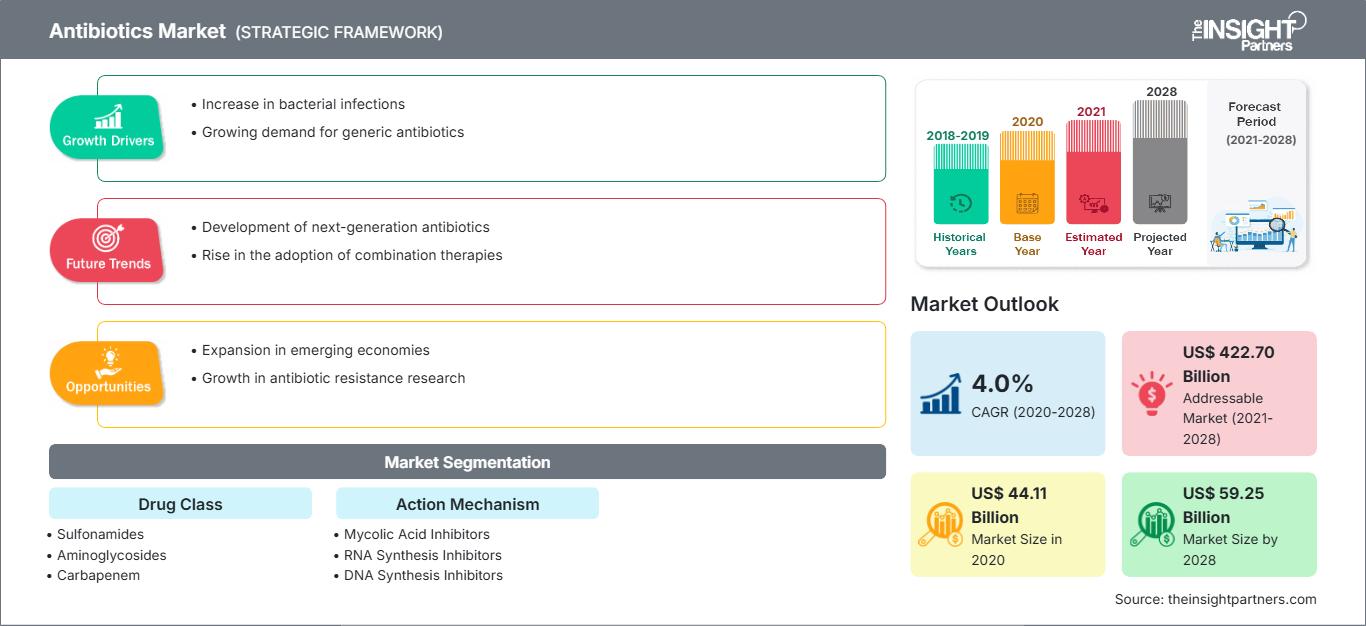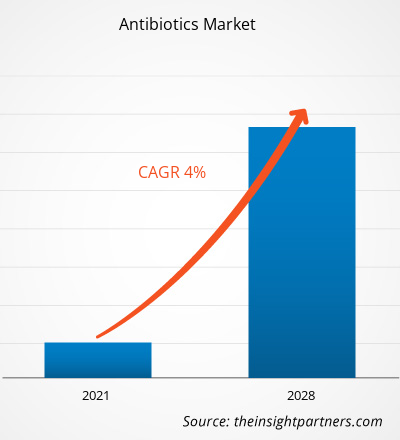항생제 시장은 2020년 441억 1,131만 달러 규모였으며, 2028년에는 592억 5,324만 달러에 이를 것으로 예상됩니다. 2021년부터 2028년까지 연평균 성장률(CAGR) 4.0%로 성장할 것으로 예상됩니다.
항생제는 박테리아 감염 및 질병 치료에 사용되는 강력한 약물입니다. 항생제는 포도상구균, 연쇄상구균, 대장균과 같은 박테리아에 의한 감염 치료에 특히 사용됩니다. 항생제는 박테리아를 사멸시키거나(살균) 증식 및 성장을 억제합니다(정균). 항생제 시장은 바이러스 감염에는 효과가 없습니다. 항생제로 치료하는 흔한 감염증으로는 결막염, 피부 또는 연조직 감염, 상기도 감염, 기관지염, 연쇄상구균 인두염(패혈성 인두염) 등이 있습니다.
시장 분석: 제네릭 의약품 개발 증가
제네릭 의약품은 특허 기간이 만료된 브랜드 의약품의 복제약입니다. 제네릭 의약품은 비용 효율적인 의약품을 제공하고 다양한 경제 계층에 대한 접근성을 높이기 위해 시장에 출시됩니다. 제네릭 의약품은 가용성과 가격 면에서 인기가 높습니다. 예를 들어, 2018년 NCBI에 발표된 연구에 따르면 브랜드 의약품의 평균 처방 가격은 제네릭 의약품의 평균 가격의 거의 4배였습니다. 또한, 제약사들은 항생제를 최소한의 비용으로 제공하기 위해 제네릭 의약품 개발에 집중하고 있습니다. 예를 들어, 2018년 6월, 루핀(Lupin)은 미국 시장에 제네릭 토브라마이신 흡입액을 출시했습니다. 또한, 정부 당국의 장려책 또한 제네릭 항생제 생산을 촉진할 것으로 예상되며, 이는 결국 예측 기간 동안 항생제 시장 성장을 견인할 것입니다. 예를 들어, 2019년 2월, 미국 식품의약국(FDA)은 인도 제약회사들이 미국에서 제조한 제네릭 의약품의 상용화 승인을 발표했습니다.
이 보고서의 일부, 국가 수준 분석, Excel 데이터 팩을 포함하여 모든 보고서에 대한 사용자 정의를 무료로 받을 수 있을 뿐만 아니라 스타트업 및 대학을 위한 훌륭한 제안 및 할인을 이용할 수 있습니다
항생제 시장: 전략적 통찰력

-
이 보고서의 주요 주요 시장 동향을 확인하세요.이 무료 샘플에는 시장 동향부터 추정 및 예측에 이르기까지 데이터 분석이 포함됩니다.
항생제 시장은 약물 종류에 따라 설폰아미드, 아미노글리코사이드, 카바페넴, 마크로라이드, 플루오로퀴놀론, 페니실린, 세팔로스포린 등으로 구분됩니다. 세팔로스포린 부문은 2020년 시장 점유율이 가장 높았으며, 플루오로퀴놀론 부문은 예측 기간 동안 시장에서 가장 높은 연평균 성장률(CAGR)을 기록할 것으로 예상됩니다.
작용 기전 통찰
작용 기전을 기준으로 항생제 시장은 미콜산 억제제, RNA 합성 억제제, DNA 합성 억제제, 단백질 합성 억제제, 세포벽 합성 억제제로 구분됩니다. 세포벽 합성 억제제 부문은 2020년 시장 점유율 1위를 차지했으며, DNA 합성 억제제 부문은 예측 기간 동안 가장 높은 연평균 성장률(CAGR)을 기록할 것으로 예상됩니다.
기업들은 전 세계적으로 사업 영역과 제품 포트폴리오를 확장하고 증가하는 수요를 충족하기 위해 제품 출시 및 승인 전략을 일반적으로 채택합니다.
항생제 시장에서 활동하는 주요 기업들은 전 세계 고객 기반을 확대하기 위해 확장 전략을 채택하며, 이를 통해 글로벌 브랜드 인지도를 유지할 수 있습니다. 예를 들어, 2019년 7월, 화이자와 같은 기업은 8개의 생명공학 파트너 및 유럽 학계와 협력하여 새로운 결핵 항생제를 발굴하고 개발하기 위한 국제 연구 컨소시엄을 출범시켰습니다.
항생제 시장 지역별 통찰력
The Insight Partners의 분석가들은 예측 기간 동안 항생제 시장에 영향을 미치는 지역별 동향과 요인을 면밀히 분석했습니다. 이 섹션에서는 북미, 유럽, 아시아 태평양, 중동 및 아프리카, 그리고 중남미 지역의 항생제 시장 부문 및 지역별 현황도 살펴봅니다.
항생제 시장 보고서 범위
| 보고서 속성 | 세부 |
|---|---|
| 시장 규모 2020 | US$ 44.11 Billion |
| 시장규모별 2028 | US$ 59.25 Billion |
| 글로벌 CAGR (2020 - 2028) | 4.0% |
| 이전 데이터 | 2018-2019 |
| 예측 기간 | 2021-2028 |
| 다루는 세그먼트 |
By 약물 종류
|
| 포함된 지역 및 국가 |
북미
|
| 시장 선도 기업 및 주요 회사 프로필 |
|
항생제 시장 참여자 밀도: 비즈니스 역학에 미치는 영향 이해
항생제 시장은 소비자 선호도 변화, 기술 발전, 그리고 제품의 효능에 대한 인식 제고 등의 요인으로 인한 최종 사용자 수요 증가에 힘입어 빠르게 성장하고 있습니다. 수요가 증가함에 따라 기업들은 제품 라인업을 확장하고, 소비자 니즈를 충족하기 위한 혁신을 추진하며, 새로운 트렌드를 적극 활용하고 있으며, 이는 시장 성장을 더욱 가속화하고 있습니다.

- 을 얻으세요 항생제 시장 주요 주요 플레이어 개요
- 세팔로스포린
- 페니실린
- 플루오로퀴놀론
- 마크롤라이드
- 카바페넴
- 아미노글리코사이드
- 설폰아미드
- 기타
글로벌 항생제 시장 - 작용 기전별
- 세포벽 합성 억제제
- 단백질 합성 억제제
- DNA 합성 억제제
- RNA 합성 억제제
- 미콜산 억제제
- 기타
글로벌 항생제 - 지역별
-
북미
- 미국
- 캐나다
- 멕시코
-
유럽
- 프랑스
- 독일
- 이탈리아
- 영국
- 스페인
- 나머지 유럽
-
아시아 태평양(APAC)
- 중국
- 인도
- 대한민국
- 일본
- 호주
- 나머지 아시아 태평양
-
중동 및 아프리카(MEA)
- 남부 아프리카
- 사우디아라비아
- UAE
- 중동 및 아프리카 나머지 지역
-
남부 미국
- 브라질
- 아르헨티나
- 남아메리카 나머지 지역
회사 프로필
- Pfizer, Inc
- Johnson & Johnson Services, Inc.(Janssen Pharmaceuticals),
- Abbott,
- GlaxoSmithKline Plc,
- Sanofi,
- Novartis AG,
- Bayer AG,
- Bristol Myers Squibb Company,
- Eli Lilly and Company,
- Astellas 제약
- 과거 분석(2년), 기준 연도, CAGR을 포함한 예측(7년)
- PEST 및 SWOT 분석
- 시장 규모 가치/거래량 - 글로벌, 지역, 국가
- 산업 및 경쟁 환경
- Excel 데이터세트
최근 보고서
관련 보고서
사용 후기
구매 이유
- 정보에 기반한 의사 결정
- 시장 역학 이해
- 경쟁 분석
- 고객 인사이트
- 시장 예측
- 위험 완화
- 전략 기획
- 투자 타당성 분석
- 신흥 시장 파악
- 마케팅 전략 강화
- 운영 효율성 향상
- 규제 동향에 발맞춰 대응






















 무료 샘플 받기 - 항생제 시장
무료 샘플 받기 - 항생제 시장